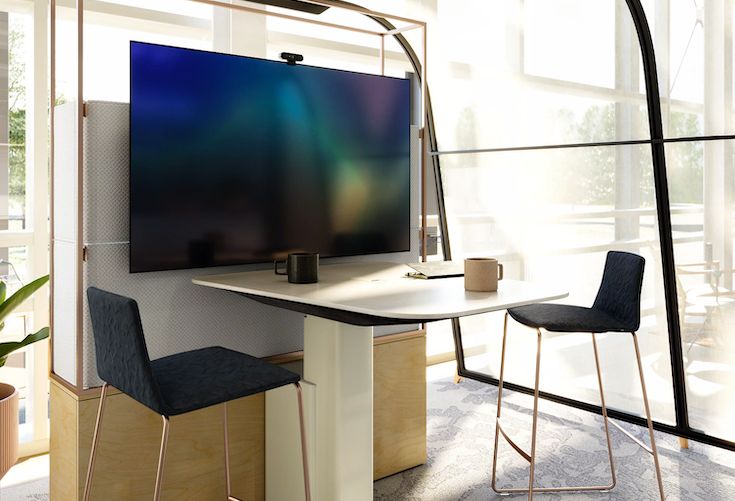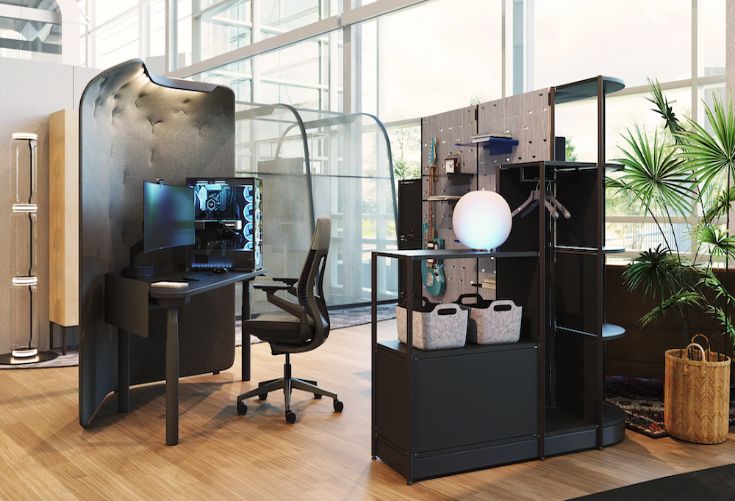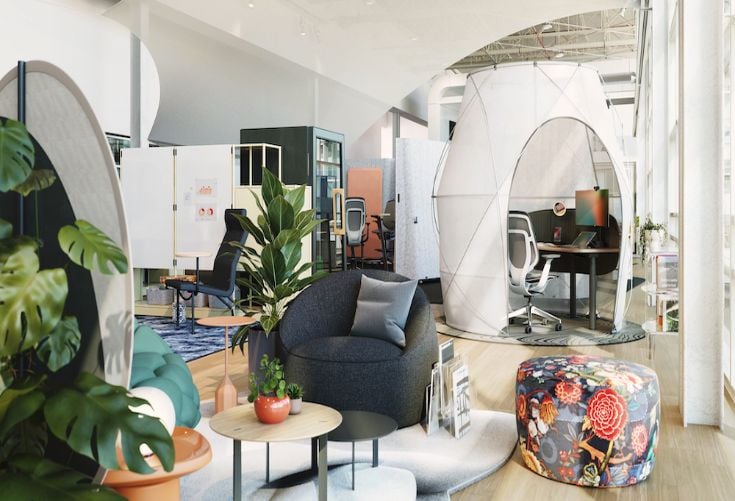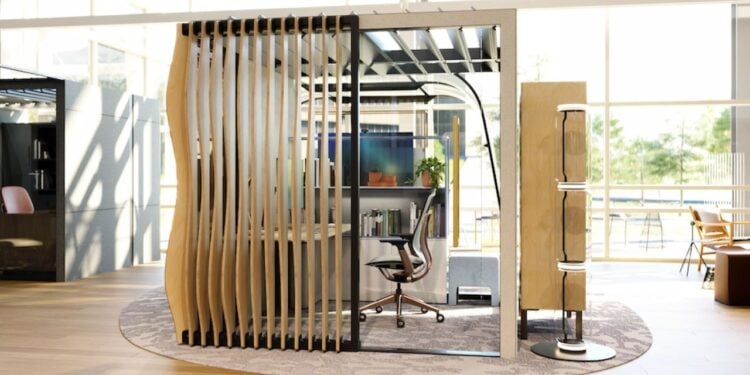- Leaders play a critical role in the adoption of hybrid work – they need to be accessible in ways they may not have considered in the past and to set the tone for what work looks like in the future.
- Steelcase conducted research with employees in 11 countries and one of the things that research showed is that people want their leaders to be visible, accessible and transparent in how they run the business.
- A leadership neighborhood includes a diverse range of owned and shared spaces that meet the various needs of hybrid work, and can include c-suite home bases, a social hub, executive assistant pods, community meeting spaces and more.
This article was written by Rebecca Charbauski and Stav Kontis, and was originally published on Work Design Magazine.
Hybrid work offers great promise while also bringing with it many challenges and uncertainty. Most organizations who choose hybrid work are trying to offer a balance between the flexibility people want and the need to bring employees together to create greater cohesion and build a sense of community.
Leaders play a critical role in the adoption of hybrid work – they need to be accessible in ways they may not have considered in the past and to set the tone for what work looks like in the future. “Congratulations. You are the new amenity,” McKinsey’s Workplace Strategy and Change Leader Phil Kirschner tells leaders. “It used to be the gym, the cafeteria, being able to bring puppies to work, whatever it is, but the executives are the new amenity.”
But the current office might be a barrier to leaders who want to be accessible and role models for hybrid. Workplace design traditionally focused on leaders’ needs by creating executive floors or suites that were set apart from the rest of the organization. It became a constraint to building transparency and made it harder for leaders to have serendipitous connections with employees. A fundamentally different approach to leadership spaces can be an important tool for building the kind of culture and fostering the kind of behaviors leaders want to see.
Accessible. Approachable. Functional.
Steelcase conducted research with employees in 11 countries and one of the things that research showed is that people want their leaders to be visible, accessible and transparent in how they run the business. For many leaders this requires new behaviors and practices, which can be a challenge because they also need to get their jobs done.
So how can leaders balance the need to be more approachable to employees yet still have space to handle the moments of crisis they’re dealing with more frequently, as well as the day-to-day needs of the organization? How can they collaborate as a leadership team and share quickly with each other as well as the larger organization? And how do they do all this in a hybrid work environment when they need to interact with people in-room and remote participants?
A new space, called the “Leader Commons” applies research and insights to create an innovative approach for leaders in a hybrid world. Located within the Steelcase Learning and Innovation Center in Grand Rapids, Michigan, it is a behavioral prototype – a fully-built-out environment where concepts are tested and evaluated in real time. Like its name implies, this space is designed to be highly accessible and approachable for employees, yet functional for the demands of leadership roles. It offers spaces where leaders can focus and collaborate, both in- person and remotely.
“We know organizations need to rebuild the social capital that was lost while everyone worked from home,” says Cherie Johnson, global design director. “Traditional leadership spaces don’t offer the transparency and accessibility people want today.”
The design was inspired by dynamic neighborhoods that have a range of diverse public and private spaces which encourages equity, engagement and ease of use to address the needs of hybrid work.
Designing a Leadership Neighborhood
The design concept of creating spaces that are more like a vibrant neighborhood is based on the belief that the workplace needs to be more inclusive and create the sense of community that people and organizations need to thrive. Neighborhoods are a tangible way for organizations to communicate their values and shift their culture.
Every neighborhood has its own distinctive character and four key design principles guide their creation.
Me + We
Just as city neighborhoods have homes and shared spaces, a leadership community should support both individual and team work.
Fixed-to-Fluid
Leaders need a highly adaptable and resilient space that can ebb and flow with their needs. The easier it is for them to make changes on demand, the more effective the space will be.
Open + Enclosed
Privacy and the ability to focus in the office has become even more important. Leaders need to be able to find the level of privacy they require.
Braiding Digital + Physical
Every space may need to be a video space. Video meetings are a new norm in the office and everyone needs to see and be seen, hear and be heard. Technology and the physical space need to be considered holistically to provide an equitable experience for both in-person and remote participants.
Topography of a Leadership Neighborhood
A leadership neighborhood includes a diverse range of owned and shared spaces that meet the various needs of hybrid work.
1. C-Suite Home Bases
Owned personal spaces for leaders that provide privacy for focus work with adjacent spaces for 1:1 collaboration.
2. Executive Assistants Pods
Workspaces provide proximity to leaders as well as to other assistants who work as a team to support leaders. Highly mobile furnishings allow for personal control and preferences.
3. Social Hub
Located at the entrance of a Leader Commons, this approachable space encourages people to gather and allows informal access to leaders. It can be an “on deck” area for people coming to attend scheduled meetings.
4. Courtyard
Located in the center of resident spaces, it’s a space where leaders can easily come together, with mobile boundary elements that can accommodate varying team sizes, provide visual and acoustic privacy and enable hybrid collaboration.
5. Front Porch
Located near main traffic thoroughfares, these informal and comfortable ancillary spaces can be used before and after meetings, as touchdown spaces, for casual conversations or for hosting guests.
6. Community Meeting Spaces
A range of fully enclosed, bookable meeting spaces are equipped to support hybrid collaboration and are available to all employees. These include Hybrid Huddle Rooms, Hybrid Active Collaboration Spaces and Hybrid Informative Collaboration Rooms. (see sidebar).
7. Communication Kiosks
Analog and digital media integrated throughout the space provide places for storytelling and messaging to both employees and guests.
A New Vision for Leadership Spaces to Support Hybrid Work
 C-Suite Home Base
C-Suite Home Base
This new kind of CEO space is highly visible, positioned on a main traffic path, yet gives leaders the privacy they need to do their work. Designed around a freestanding pod, the space has multiple areas for different kinds of work. Close the sliding door for deep focus work or video calls (each leader has a curated background that speaks to who they are).
Integrated technology and easy access to work tools makes this compact space highly effective for deep focus and hybrid 1:1 collaboration.
An aside space to the pod serves as a back porch that signals availability and allows quick shifts for collaboration with both in-person and remote participants. A height-adjustable table behind the pod provides a place for 1:1 meetings or to connect virtually.
C-Suite Home Base: An Alternative Approach
For leaders who prefer a more open environment, boundary elements provide shielded privacy and the opportunity to personalize the space.
 Social Hub
Social Hub
An approachable and multipurpose café space for leaders and employees to meet; ideal for connecting before and after meetings with leadership. It also includes touchdown spaces for people to do individual work.
 Remote Leader Space
Remote Leader Space
This novel approach gives remote leaders a place to call home when they are in the office. A “work tent” for individual work, a front porch for informal meetings, and a freestanding acoustic pod provide a range of spaces from which to choose.
 Leading by Example
Leading by Example
Bringing people back together recharged and reinvigorated is perhaps the greatest challenge leaders have today, regardless of what their hybrid work strategy may be. There’s never been a greater time for leaders to lead by example and demonstrate the culture and behavior they expect from their employees, which will require a new approach to leadership spaces.

 Dr. Gleb Tsipursky – The Office Whisperer
Dr. Gleb Tsipursky – The Office Whisperer Cat Johnson – Coworking Marketing Maven
Cat Johnson – Coworking Marketing Maven Angela Howard – Culture Expert
Angela Howard – Culture Expert Drew Jones – Design & Innovation
Drew Jones – Design & Innovation Andrea Pirrotti-Dranchak – Competitive Advantage
Andrea Pirrotti-Dranchak – Competitive Advantage















